Simplicity of materials and structural complexity, a constructive wisdom handed down over time. The trebuchets are ancient fishing machines typical of the Adriatic coasts of Abruzzo and Puglia.
The trebuchets are ephemeral architectures of precarious beauty, icons of the Adriatic coastal landscape, archetypal efficient building, with materials and local workers, at no cost.
These fishing vernacular architectures take different names, depending on the geographical area of belonging. Thus, in the Garganica region of Puglia, it will be Trabucco; while in Abruzzo and Molise it is called Trabocco. To say one or the other is equivalent to express the same concept, although as we shall see later on there are subtle differences. For this reason, in the text, I will use one or the other term interchangeably. Small digression: there are different versions but simpler also in other parts of Italy, on the Lazio (bilancioni) and Romagna coasts and in the Venetian lagoon.
The structure of the Trabocco, solid and robust, is an ingenious example of sustainability: self-construction (fruit of constructive wisdom, passed on orally), local and natural materials (wooden structure and hemp for joints), respect for the environment and reversibility (each element can be removed without damaging the habitat). This is because the vernacular “does not follow whims or fads … It is commensurate with human dimensions and human needs, without frills, without the hysteria of the designer… The simple reliance on local building materials ensures that time-honored construction methods persist.” (B. Rudofsky)
Muse of people and poets, which inspired D’Annunzio in his famous story “The triumph of death”, the trebuchet is a refined prototype of bioclimatic architecture, a way of building in harmony with nature, made of understanding and respect. A spontaneous, regional, vernacular architecture, expression of the “genius loci” and masterful constructive synthesis, which combines the simplicity of materials, with the complexity of the structural conception. In recent years, also thanks to a strong tourist promotion, there is a capillary work of redevelopment of the historical trebuchets, some disappeared, others reduced to ruins or traces of marine carcasses.
History, origin and evolution
New York, 1964. At the MoMA (Museum of Modern Art) a photographic exhibition set up by the Austrian architect Bernard Rudofsky entitled “Primitive Architecture”. Alongside the numerous testimonies of vernacular architecture scattered around the world (Stonehenge, Apulian trulli, primitive huts in Asia and Africa, buildings in raw earth, fortified villages, houses-pile-houses, warehouses-fortresses, casegrotta of the Padocia Capocia in Turkey), also appeared – for the first time in a museum – the Trabucchi (or Trabocchi). Since then, the fame, interest and curiosity around these ancient fishing machines grew exponentially.
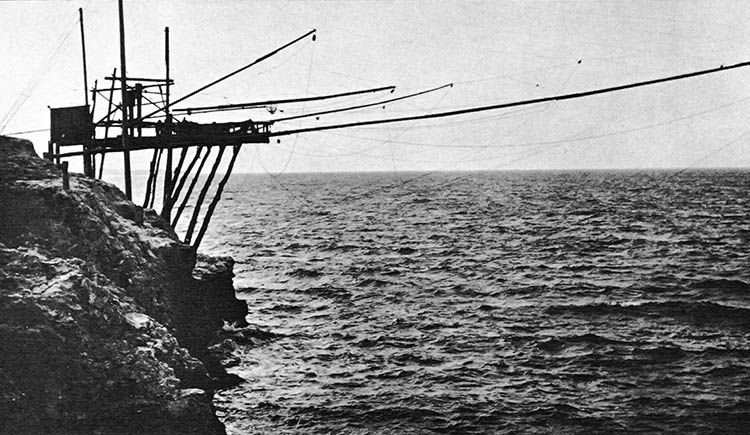
Trabucco Garganico, Vieste, anni ’60 (B. Rudofsky, Architecture without Architects)
Witnesses of the collective memory and the Italian maritime identity, the Trabucchi are ancient fishing tools spread along the Adriatic coasts of Gargano, Abruzzo and Molise, designed by local populations to intercept and capture, By staying ashore, the flocks of fish transiting along the coasts (“mail” fishing), without going to sea with boats. Thus avoiding all the risks of bad weather.
There are different hypotheses about its origins. For some scholars, the name trabucco comes from the Latin “trabs”, or trave. For others, it is derived from the ancient French “Trabone”: an ancient wall machine to cast. There are those who associate this invention with the Phoenicians. Who still traces its origins back to 1240, in the writings of Pietro da Morrone, tracing its traces in the description of the panorama on the sea. Or who attributes the creation of the first fishing machines on the coasts of Abruzzo to 1627, thanks to the craftsmanship of Jewish exiles from France (Petro Cupido, 2003).
Initially there were only walkways – made of wood and hemp ropes – with fishing nets, then added other building elements that made these machines, yes beautiful and complex. The first certain and documented traces of their presence on the Adriatic coasts are attested, however, only at the end of 1700.
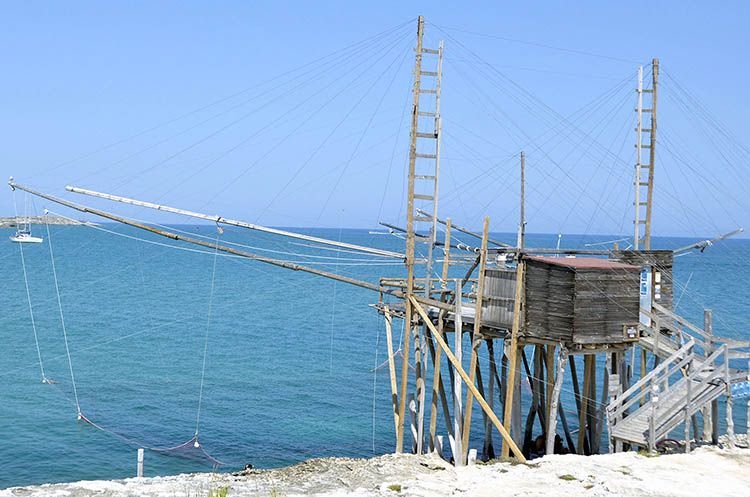
Trabucco di San Lorenzo (Vieste), overview. Note the various restoration interventions expressed in different shades of wood
Over time, technological developments are taking place. With the construction of the railway on the coast – completed in 1863 – there are large quantities of ferrami – plates, bolts, nuts and rails – that will replace the hemp ropes joints. New and more modern systems of joints and joints, will become firmly part of the tradition of construction overflows, as we know them today.
Even the fishing net – sewn in cotton, in the past – already from the fifties will be made of nylon. Having lost their original function as a source of income and subsistence for many families (up to 4-5 per trebuchet), there has been a progressive abandonment since the 1970s: shipwrecks, carcasses of primitive marine monsters, But still rich in historical meanings, imprinted in the memory of a romantic time. They are the bearers of technical and technological knowledge, of building, expression of manual and intellectual skills.
Fortunately local administrations, citizens and associations, aware of this, have allowed in recent years the recovery of a good part of these extraordinary vernacular machines. This was not possible without trauma for their primordial spirit. Their function has in fact undergone a change of use, from fishing machine to machine to the service of seaside tourism. Where it has not taken the actions of the monument as a means of valorization of the territory, it is often destined for lavish banquets and varied temporary events.
Functional characteristics of the trebuchets
The trebuchets are wooden constructions, born as an alternative to fishing by boat. Thanks to these marine stilts, it is possible to catch from land the schools of fish transiting along the coasts (fishing “mail”), avoiding the pitfalls of the open sea.
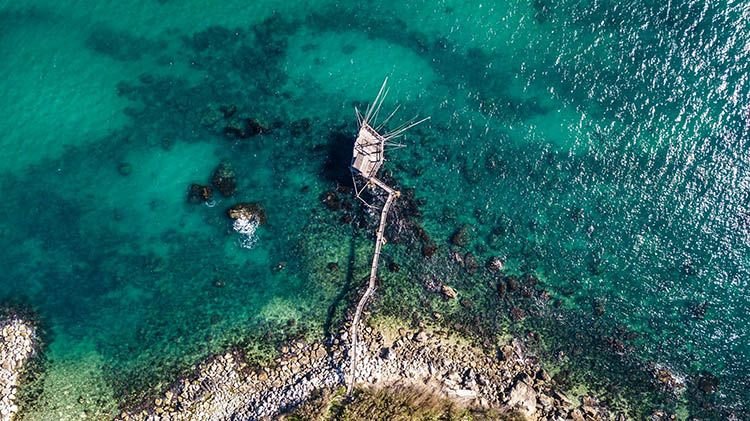
Trabocco Turchino,
Ductility and lightness, are the two qualities that a trebuchet must always have. The construction must be ductile in order to be able to accommodate the movement of the sea, bending without damage. And the lightness is guaranteed by the material. Originally, in fact, the whole structure was made of wood, with ligatures between the parts in hemp rope. The joints were then replaced by metal joints such as plates, bolts and nuts. This is how they look today.
Depending on their location, the trebuchets can be classified into pier or rock trebuchets. According to the local climatic characteristics, and in particular depending on the prevailing winds to which they are exposed, one can distinguish between East and West trebuchets.
A trebuchet oriented to master or west (north, north-west) will be exposed to more violent swells and winds, as a result, it will need stronger and more resistant woods. One aimed at “east” or “sirocco”, instead, will have to withstand winds and storms of less intensity and therefore can rely on more “soft” wood.
Constructively, the trebuchet is designed for easy replacement of deteriorated parts. The perpetual exposure to atmospheric agents, salt water and the devastating force of the sea is a cause of strong degradation for wood that, as we know, fears moisture and even more seawater. Today, protective treatments are frequently used to increase their natural durability. The metal parts also become weak, corroding and rusting.
“The machine seemed to have a life of its own, with an air and an image of an animated body. Wood exposed for years and years to the sun, rain, gusts, showed all its fibers, put out all its roughness and all its knuckles, revealed all the resistant particularities of its structure, it It became as white as a tibia or as shiny as silver or as grey as flint, acquired a special character and significance, a distinct imprint as that of a person on whom old age and suffering had done their cruel work”. (G. D’Annunzio, “The Triumph of Death”).
The trebuchet does not aspire to eternity, to technological supremacy, but he turns discreetly towards the sea. “One does not claim to win the nature, but with it one has chosen to come to terms, surrender and regenerate however easily” (F. Laner).
Trabucco garganico vs trabocco abruzzese
The trebuchet, as we have already mentioned above, presents aesthetic and technical-constructive differences according to its territorial location. There are basically two types of fishing machines: the Garganico type and the Abruzzo type. The first one is spread mostly on the coast near Vieste, the second is instead a characteristic presence of the Teatina coast, between Ortona and Vasto, in the province of Chieti.
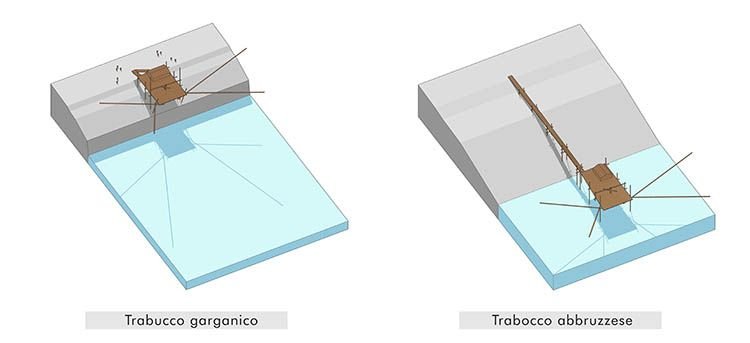
Another important element, which distinguishes the two types is a consequence of the first. The garganic trebuchet, being installed on the shore – raised on a cliff -, can be anchored to it. And in fact, another element of identity of the Apulian type, are the Stralli. That is, a plurality of wooden poles stuck to the ground, not far from the platform, connected with cables and metal ties, joined to the antennas, poles and beams of the fishing machine and which function as counter-fans. Sometimes, then, it presents a pair of winches for the operation of the nets, instead of having only one.
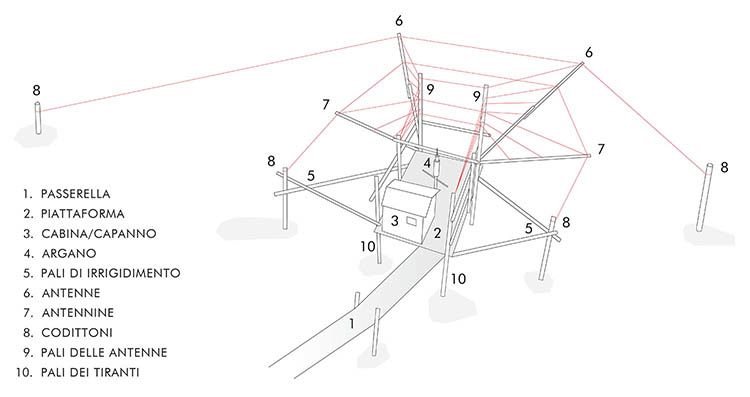
- 1 runway – 2 Platform – 3 Cabin – 4 Winch – 5 Support pole – 6 antennas – 7 Antennas – 8 Codditons – 9 Antennas Pole – 10 Bored piles
- (maybe the translation can be worng)
Conservation, restoration and transmission of knowledge
The trabucchi are extraordinary fishing machines, expression of the culture and tradition of a people strongly linked to the marine activity as a source of subsistence and economic. Artefacts that expertly embody the spirit of the place, through the use of local materials and technical-constructive simplicity skillfully handed down from generation to generation, from father to son.
They are a historical testimony of the seafaring popular identity, and must therefore be preserved as precious treasures. The rediscovery of this peculiar architectural and cultural heritage has led several local authorities to initiate actions for protection and recovery. The Abruzzo Region has already enacted ad hoc laws since 1994, Puglia only arrived in 2015.